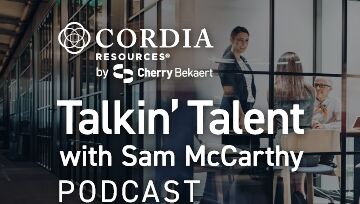“We’ve never before seen the degree of difficulty and complexity that CEOs face today.” Those were the words of former Chrysler and Home Depot CEO, Bob Nardelli, when he joined me for a fascinating discussion at Cherry Bekaert’s recent Modernizing Manufacturing symposium.
And it’s hard to disagree. With the extraordinary disruption of the pandemic still ongoing, manufacturing leaders must now also contend with the combined effects of a growing labor crisis, soaring interest rates, uncertain supply chains and a devastating war in Ukraine. All alongside rising pressure to act on key societal issues, such as injustice and climate change.
It is no surprise that Nardelli’s view was shared by fellow symposium speaker Jason Hodell, former CEO of headphones manufacturer, Skullcandy. In fact, he added one more item to the lengthening list of CEO challenges: the increased risks and costs associated with working in China and other parts of Asia. “Most of these issues aren’t going away either,” he insisted. “What we have now is the new normal.”
Reverse Globalization
What exactly do these challenges look like? Faced with such a perfect storm, how should the manufacturing industry respond if it is to successfully steer its way towards a brighter future? “Simple,” says Nardelli. “Innovate or evaporate.”
For many firms, this should begin with rethinking where they actually make their products. As the price of labor in Asia grows and the impact of trade tariffs with China intensifies, manufacturers face ever more unsustainable operating costs in what, for a long time, has been a geographical bedrock of the industry.
Combine that with the unpredictability of international freight times and it is easy to see why many firms are giving serious thought to reshoring or nearshoring their operational bases to the US and Mexico in a bid to better manage risk and find a competitive edge. “The reverse of globalization,” as Hodell put it.
Myth-busting
Yet innovation is also required closer to home. Indeed, another urgent challenge for manufacturing firms to address is to figure out how to win the war on talent – a war in which they must no longer simply outdo each other, but also go toe-to-toe with the likes of Silicon Valley to secure the best people.
As Marshall Cooper, CEO of Chief Executive Group and another of our symposium speakers, pointed out, much of this comes down to reputation rather than operation. Manufacturers, he told us, need to increasingly think “like marketers,” focusing on improving their employer brand if they are to attract a new generation of digitally-skilled workers.
As an industry, that means dispelling the myth that manufacturing is still a world of dirty, dark factories and instead showcasing the modern, high-tech, automated environment of today. It means working more closely with colleges and schools to introduce young people to the realities of a career in 21st-century manufacturing. Finally, it means looking beyond traditional heartlands to recruit a more diverse pool of talent into the industry.
Staying Power
Of course, bringing in a new generation of workers, including those from previously overlooked or underserved communities, is just one part of manufacturers’ people puzzle. They must also refresh their approach to retaining them.
Use onboarding as an example. Rather than the traditional checkbox exercise of introductions and orientation during week one, manufacturing companies should consider offering new joiners, especially those entering the industry for the first time, what Cooper described as a “mini-MBA.” This would involve a far more rigorous and prolonged introduction to the various departments and functions of the business, allowing them to fully understand how everything from sales and marketing to engineering and logistics knit together to drive growth.
Beyond onboarding, C-suite engagement is also more important than ever when it comes to making people feel valued and empowered. Today’s workers, particularly Millennials and Gen Z, expect to be leaders. They view responsibility and progression as a function of ability, not longevity. And they want regular interaction with those at the top of the business – even if, in many cases, this will happen from a remote-work environment rather than in the office or on the shop floor.
Adopting a servant leadership style can therefore help CEOs deliver on these needs, keeping hold of their best people while benefitting from their own enhanced ability to identify potential rockstars around the business. They can then ensure this top-talent segment receives the necessary training and development opportunities to stay and grow with the firm, rather than take their skills elsewhere.
Faster Than the Speed of Change
Of course, no one is suggesting such change will be easy or instant. But across the symposium, whether during the speaker sessions or in general conversation around the room, there was widespread agreement that it is necessary – and increasingly pressing. The unparalleled challenges of today’s operating landscape are here to stay, which means firms must find new, more effective ways to navigate them.
Tomorrow’s manufacturing industry will be less about just-in-time and more about just-in-case, less about globalizing and more about regionalizing and less about a culture of hard work and more about a culture of continuous improvement. Only those firms that are ready, willing and able to evolve with this shifting environment can expect to lead and succeed in it. As Nardelli said, “If your rate of change internally isn’t greater than the rate of change externally, you’re backing up.”




